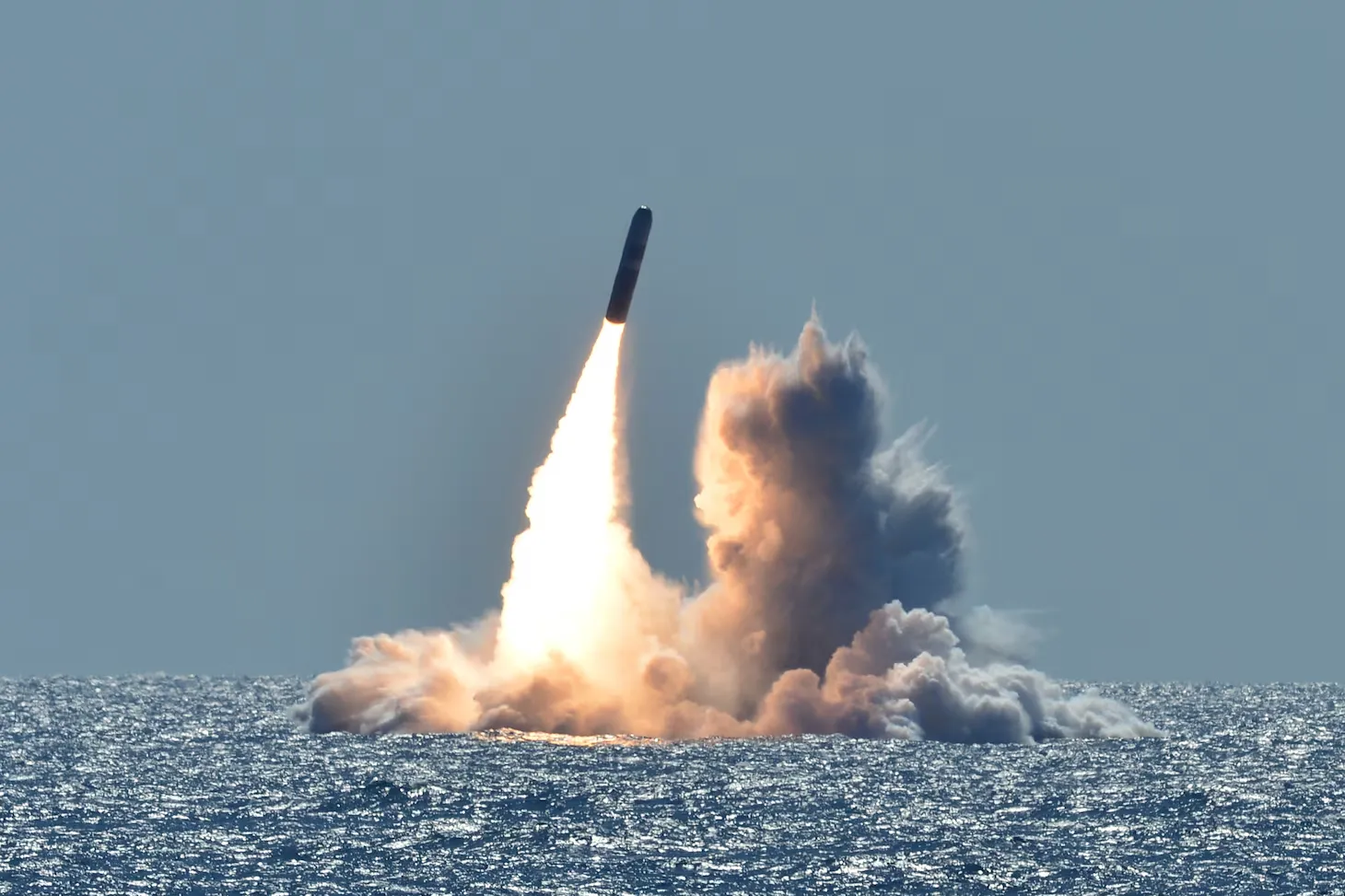
U.S. Navy Awards Lockheed Martin $383 Million for Next-Generation Strategic Deterrence at Sea
The United States Navy has awarded Lockheed Martin a $383 million cost-plus-incentive-fee and cost-plus-fixed-fee modification to its existing contract, further solidifying the company’s role in developing the next generation of the Trident II Strategic Weapons System (SWS) D5 missile. This contract modification ensures the continued advancement of sea-based strategic deterrence, a crucial component of national security and global stability.
Ensuring a Credible Sea-Based Deterrence
Under this contract extension, Lockheed Martin will design and develop the upgraded version of the Trident II missile, named the Trident II D5 Life Extension 2 (D5LE2). This modernized missile will be integrated into the U.S. Navy’s COLUMBIA-class ballistic missile submarines, ensuring that the strategic weapons system remains credible and effective through 2084.
This latest evolution of the Trident II missile is essential for maintaining a robust nuclear deterrence capability in the face of emerging threats. The United Kingdom, under the Polaris Sales Agreement, will also benefit from the upgrades, further strengthening the allied nations’ strategic security commitments.
“The second life extension of the Trident D5 missile will enable the United States and the United Kingdom to maintain credibility in deterring evolving threats,” said Jerry Mamrol, vice president of Fleet Ballistic Missiles at Lockheed Martin. “We are proud to continue our critical partnership with the U.S. Navy to take deterrence into this new era.”
Trident II: A Pillar of National Security
The Trident II D5 missile, developed and maintained by Lockheed Martin, is widely regarded as the most advanced submarine-launched ballistic missile (SLBM) in the world. It currently serves as the primary nuclear deterrent aboard U.S. OHIO-class and U.K. VANGUARD-class submarines. The missile system is known for its precision, reliability, and ability to penetrate enemy defenses, making it a cornerstone of the United States’ and its allies’ strategic defense posture.

As Lockheed Martin marks 70 years of support for the Navy’s Fleet Ballistic Missiles (FBM) program, this new contract modification reinforces the company’s long-standing role in preserving American and allied security. Over the decades, Lockheed Martin has continuously enhanced the Trident missile’s capabilities to meet the evolving challenges of modern warfare. The D5LE2 program represents the next step in ensuring that the U.S. maintains technological superiority in the strategic deterrence arena.
Modernizing for the Future
Lockheed Martin’s Fleet Ballistic Missiles program is dedicated to sustaining and advancing the U.S. Navy’s nuclear deterrent mission. By leveraging cutting-edge digital technologies, innovative design methodologies, and state-of-the-art manufacturing processes, the company aims to enhance missile performance, reliability, and security. These advancements include:
- Improved Guidance Systems: The D5LE2 will feature upgraded navigation and guidance systems to maintain superior accuracy over long distances.
- Enhanced Survivability: New materials and design modifications will improve the missile’s resilience against countermeasures and evolving threats.
- Extended Service Life: The life extension program ensures that the Trident II system remains viable and effective through 2084, supporting the U.S. Navy’s long-term strategic goals.
The D5LE2 will be deployed aboard the next-generation COLUMBIA-class ballistic missile submarines, which are set to replace the aging OHIO-class fleet. These new submarines will serve as the backbone of the U.S. Navy’s nuclear deterrent force well into the late 21st century, making it imperative that their strategic weapons remain at the forefront of technological excellence.
Expanding Infrastructure to Support Production
To support the development and production of the Trident II D5LE2 missile, Lockheed Martin is investing in new infrastructure, including a significant expansion in Florida’s Space Coast region. The company has announced plans to construct a 225,000-square-foot facility in Titusville, Florida, dedicated to producing components for the new missile system.
This expansion not only strengthens Lockheed Martin’s manufacturing capabilities but also brings significant economic benefits to the region. The facility is expected to create approximately 300 highly skilled jobs, further cementing Florida’s role as a hub for aerospace and defense industries.
“Under Governor Ron DeSantis’ leadership, Florida continues to invest in our aerospace, aviation, military, and defense industries—bringing high-skill, high-wage jobs to the state,” said Florida Secretary of Commerce J. Alex Kelly. “Strategic investments like this continue to propel Florida’s workforce, adding 300 new jobs and bringing economic success to Florida communities.”
The new facility is anticipated to be operational by 2027, aligning with the Navy’s production schedule and ensuring that the next generation of submarine-launched ballistic missiles is delivered on time. This long-term investment in advanced manufacturing will help sustain the U.S. Navy’s deterrent capabilities for decades to come.
Strategic Importance of the Trident II D5LE2 Program
The Trident II D5LE2 missile program is not just a technological advancement—it is a critical component of the United States’ national security strategy. As global threats continue to evolve, maintaining a strong and credible deterrent force is paramount. The modernization of the Trident missile system ensures that the U.S. and its allies remain prepared to counter potential adversaries.
The importance of a reliable and advanced sea-based deterrent cannot be overstated. Unlike land-based missile systems, which can be more easily targeted, submarine-launched ballistic missiles provide an unmatched level of survivability. The ability to launch a second-strike response in the event of a nuclear conflict reinforces global stability by discouraging potential aggressors from engaging in hostile actions.
With the introduction of the D5LE2, the U.S. Navy is demonstrating its commitment to maintaining a credible nuclear deterrent through technological innovation and strategic investment. The partnership between Lockheed Martin and the Navy has been instrumental in ensuring the success of the Trident program, and this latest contract modification further strengthens that collaboration.
Looking Ahead: The Future of Sea-Based Deterrence
As geopolitical tensions fluctuate and adversaries develop new capabilities, the modernization of the U.S. strategic weapons arsenal remains a top priority. The Trident II D5LE2 program is a testament to the Navy’s proactive approach in addressing future threats and ensuring national security.
Lockheed Martin’s investment in digital engineering, advanced manufacturing, and new infrastructure will play a crucial role in delivering the next generation of deterrence capabilities. The construction of the Titusville facility, coupled with ongoing research and development efforts, underscores the company’s commitment to supporting the Navy’s mission well into the 21st century.
As the COLUMBIA-class submarines prepare to enter service, the deployment of the D5LE2 missile will mark a new chapter in the U.S. Navy’s strategic deterrence program. This next-generation missile will continue the legacy of the Trident system, providing unmatched reliability, accuracy, and survivability.
In conclusion, the U.S. Navy’s $383 million investment in the Trident II D5LE2 program reflects the nation’s unwavering commitment to maintaining a robust and effective nuclear deterrent. With Lockheed Martin leading the charge in missile development and manufacturing, the United States and its allies will remain well-equipped to address the challenges of an evolving security landscape. The continued evolution of sea-based deterrence is not only essential for national defense but also for preserving global stability and deterring potential conflicts in the decades ahead.




